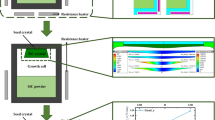Abstract
In an attempt to systematically control dislocation substructure, seeded <111>Cu single crystals have been grown from the melt at rates from 1.1 to 730 cm/h. Soft and hard graphite molds are used, with the hard molds surrounded by graphite or firebrick sleeves. In this fashion mold wall characteristics are varied and mold thermal conductivity is changed from 27×10−4 to 0.29×10−4 (cgs units). An increase in growth rate over this range has little effect on random dislocation density, which remains about 1.5×106 cm−2. The increase does cause a decrease in dislocation cell size from about 5×10−2 to 0.5×10−2 cm. The decrease varies approximately as (freezing rate)−1/2 in agreement with the dislocation half-loop model of dislocation generation. An increase of mold thermal conductivity of a factor of 100 has little effect on random density, but causes a 50 to 300 pct increase in cell size. Crystals grown in soft molds have a random density about one-half those grown in hard molds. The cell size is comparable to that obtained with firebricked-sleeved hard molds of similar thermal conductivity. The data indicate that solute effects do not play a significant part in substructure generation in copper of 99.999 pct purity.
Similar content being viewed by others
References
H. Akita and N. F. Fiore:J. Phys. Chem. Solids, 1970, vol. 31, pp. 1941–45.
H. Akita and N. F. Fiore:J. Appl. Phys., 1971, vol. 42, pp. 2203–08.
J. Friedel:Dislocations, chap 7, Addison-Wesley, Reading, Mass., 1964.
W. A. Tiller: inThe Art and Science of Growing Crystals, J. J. Gilman, ed. pp. 276–90, Wiley, New York, 1963.
C. Elbaum:Prog. Metal Phys., 1959, vol. 8, pp. 203–53.
B. Chalmers:Principles of Solidification, pp. 56–60, Wiley, New York, 1964.
F. W. Young, Jr., and J. R. Savage:J. Appl. Phys., 1964, vol. 35, p. 1917–24.
K. R. Evans and W. Flanagan:Phil. Mag., 1966, vol. 14, pp. 1131–42.
T. S. Noggle:Rev. Sci. Inst., 1953, vol. 24, pp. 184–88.
R. R. Rowland:Trans. Faraday Soc., 1951, vol. 47, pp. 193–97.
R. Schuman, Jr.:Metallurgical Engineering, p. 376, Addison-Wesley, Reading, Mass., 1952.
J. D. Livingston:J. Appl. Phys., 1960, vol. 31, pp. 1071–76.
K. A. Jackson:Phil. Mag., 1962, vol. 7, pp. 1117–27.
F. C. Frank: quoted inProg. Metal Phys., vol. 8, pp. 203–53.
W. A. Tiller and J. W. Rutter:Can. J. Phys., 1956, vol. 34, pp. 96–121.
Author information
Authors and Affiliations
Additional information
H. AKITA and D. S. SAMPAR, formerly with Department of Metallurgical Engineering and Materials Sciences University of Notre Dame, Notre Dame, Ind. 46556
Rights and permissions
About this article
Cite this article
Akita, H., Sampar, D.S. & Fiore, N.F. Substructure control by solidification control in cu crystals. Metall Trans 4, 1593–1597 (1973). https://doi.org/10.1007/BF02668013
Received:
Issue Date:
DOI: https://doi.org/10.1007/BF02668013




